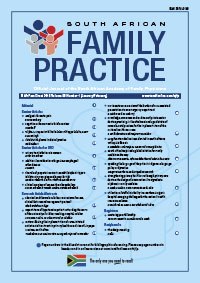HIV in acute care: a review of the burden of HIV-associated presentations to an Emergency Department
Keywords:
Emergency Department, HIV testing, human immunodeficiency virus (HIV), opportunistic infections, presentations, South Africa
Abstract
Objective: To determine the burden of human immunodeficiency virus (HIV) disease and co-infection on a district-level Emergency Department (ED) in KwaZulu-Natal. Methods: A retrospective chart review was conducted of the case notes of adult medical patients who presented to the ED over a three-month period. Patients presenting with HIV disease and its complications were identified. Patient demographics, disease presentation and severity, investigations and procedures undertaken, and disposition of patients in the HIV-positive cohort were assessed. Results: 428 of the 861 (49.7%) medical patients presenting to the ED were HIV positive. Some 37% of patients did not know their HIV status. In the HIV-positive cohort, the median age of presentation was 37 years, with almost equal male-to-female distribution. Of the patients seen, 57.5% were referred and 68% of patients presented after hours. In total, 80% of patients were triaged as yellow code. The predominant systems involved were the respiratory and central nervous systems, with pulmonary tuberculosis, community-acquired pneumonia and meningitis being the most common diagnoses. X-rays and laboratory testing were the most common investigations requested. Lumbar punctures, pleural paracentesis and pericardiocentesis were common emergency procedures performed. The majority (89.3%) of patients were admitted to the medical ward. Of the HIV-positive patients, 33% were on anti-retroviral therapy. ED mortality was 1.9%. Conclusion: In South Africa, very little is known about the ED’s ability to cope with the HIV epidemic. This study highlights the significant impact HIV places on the resources of an ED. Strengthening of the primary health care system with a more aggressive approach to HIV testing and ARV initiation may contribute positively to reducing the burden of HIV emergencies and co-morbidities presenting to the ED. (Full text available online at www.medpharm.tandfonline.com/ojfp) S Afr Fam Pract; DOI: 10.1080/20786190.2015.1079027
Published
2016-03-15
Section
Research Articles
By submitting manuscripts to SAFP, authors of original articles are assigning copyright to the South African Academy of Family Physicians. Copyright of review articles are assigned to the Publisher, Medpharm Publications (Pty) Ltd, unless otherwise specified. Authors may use their own work after publication without written permission, provided they acknowledge the original source. Individuals and academic institutions may freely copy and distribute articles published in SAFP for educational and research purposes without obtaining permission.

